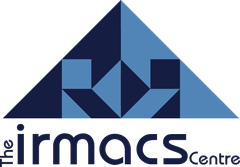2013 Abstracts
High-Order Finite-Difference Methods for Modelling Electromagnetic Wave Propagation
Finite-difference methods are a popular choice for solving systems of partial differential equations (PDEs) numerically. Throughout my work, I employ finite-difference methods to solve the various systems of PDEs that arise in common electromagnetic problems. One of the most important recent developments in finite-difference methods has been the use of finite-difference approximations with an increasable order of accuracy. The ability to increase the order of accuracy of the employed approximations can considerably improve performance; however, to exploit high-order approximations effectively, it is necessary to clearly understand how to incorporate boundary conditions. This issue, which stands as the biggest barrier to the widespread adoption of high-order methods, will be the subject of the talk.
Simulating Smoke without Volumes
In computer graphics, and visual effects in particular, smoke simulation has become a standard tool. Typically it is modeled with incompressible fluid flow on a 3D grid, tracking soot concentration and velocity in the air, and calculating buoyancy and pressure forces to evolve it forward; volume renderers can take the soot concentration as input to produce the final images. However, this doesn't scale very well, particularly to real-time applications like video games where even the volume rendering alone is unacceptably expensive relative to the rest of the application. This calls for a little more mathematical analysis and algorithmic creativity! In many circumstances, we can model the soot concentration as uniformly smoky inside a region sharply bounded by a dynamically evolving surface; vorticity likewise provides a much more efficient representation of the velocity field. Avoiding any use of volume data, we can get to interactive simulation and highly efficient real-time rendering.
Inference algorithms for continuous time Markov chains over large state spaces
Continuous time Markov chains (CTMCs) is a fundamental modeling tool in time series analysis, phylogenetics and many other areas of statistics. In most applications, simplifying assumptions are typically made to reduce the state space of the CTMCs to a finite and typically small collection of objects (in phylogenetics, for example, the four nucleotides). However, new questions and new data types motivate the development of CTMCs over strings, graphs and other countably infinite spaces. In this talk, I will describe some of our recent work on models and algorithms for analyzing CTMCs over countably infinite space. The first part of the talk will be devoted to the Poisson Indel Process, a model for string-valued CTMCs, and the second part, on inference on CTMCs over other countably infinite spaces. I will focus on applications in phylogenetics, but many of the algorithms and models have potential uses in other branches of applied statistics.
Combinatorial dichotomy classifications
In classifying the complexity of certain homomorphism problems, it sometimes turns out that it is the presence of a combinatorial obstruction in the target structure that causes a problem to become intractable. I will discuss several recent results of this type, including recent joint work with Egri, Larose, and Rafiey.
Automation for the generating series of coloured set partitions
The equidistribution of many crossing and nesting statistics exists in several combinatorial objects like matchings, set partitions, permutations, and embedded labelled graphs. The enumeration of such objects according to their crossing or nesting number has been a challenge, often resulting in hard to solve functional equations. When both nesting and crossing numbers are bounded, the generating series are rational for (arc-)colouredmatchings, set partitions, and permutations shown by Chen and Guo, Marberg, and Yen respective. We describe algorithms implemented in Maple that give the rational generating series for non-crossing, non-nesting, c-coloured set partitions and permutations. The success of the implementation leads to the possibility of automation for more complicated structures and provides new directions of attack for previously unsolved functional equations.

